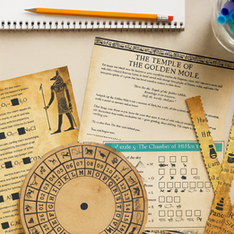Master Mole Calculations with the BOING-A-MOLE Game: An Engaging Alternative to Worksheets
- Androy
- Mar 28, 2024
- 4 min read
Updated: Mar 21

Teaching the mole concept is no small feat. Students often struggle to grasp its abstract nature, juggle the math involved, and get enough meaningful practice. Worksheets have their place, but they don’t always inspire the engagement or collaboration students need to truly master this topic.
What if there were a way to make mole calculations interactive, exciting, and memorable?
I would like to introduce you to BOING-A-MOLE, a game I created to truly engage my students , let them have some fun and get lots of essential practice with this topic.
In this post, you’ll learn how to play this creative mole calculation game and discover why it’s a hit with chemistry students.
Why Do Students Struggle with the Mole Concept?
First of all lets really think about why our students are struggling. A few of the main reasons are:
It’s Abstract: Grasping that a mole represents 6.022 × 10²³ particles is a leap into the conceptual. Also students tend to lose it when dealing with really large numbers... not to mention when those numbers are written in scientific notation.
It’s Math-Heavy: Conversions between moles, mass, volume, and particles can overwhelm students lacking confidence in math. And unfortunately in recent years our science students are lacking in that area.
It Requires Practice: Without varied and consistent practice, students often struggle to solidify their understanding.
If Your Students need a little practice with the basics you can check out the Math for Science Series of worksheets which really breaks this down.
Why Worksheets Fall Short
When it comes to giving students practice with challenging topics like the mole concept, worksheets are often our go-to resource—and for good reason. They’re easy to use, readily available, and familiar to both teachers and students. That said, while worksheets have their place in the classroom, they do come with some limitations, particularly when tackling complex topics like the mole concept and stoichiometry.
Worksheets can feel monotonous and disengaging.
Students miss out on opportunities for teamwork and discussion.
They don’t cater to different learning styles or paces.
How to Play BOING-A-MOLE
1.Set Up the Boards:
Each player begins with two boards: one to manage their mole tokens and another to track their opponent’s moves. These boards are grids featuring 25 mole calculation questions, covering key conversions:
Moles to mass
Mass to moles
Moles to particles
Particles to moles
Mass to particles
Particles to mass
Players secretly place their mole tokens on their own grid before the game starts. Each player receives 10 tokens in total, divided into groups of 4, 3, 2, and 1 mole(s). These tokens can be positioned either vertically or horizontally on their board. The aim is to strategically hide your tokens to make them difficult for your opponent to locate—similar to the classic game Battleship!

Selecting Questions:
Players take turns choosing a square on their opponent’s board and attempting to answer the mole calculation question associated with that square. For instance, if Player A selects D4, they must solve the corresponding question to progress.
The questions range in difficulty, ensuring a mix of challenges for all players.
Marking the Results:
After answering a question, the player’s opponent checks their answer against the answer key provided on their board and marks the result using one of three tokens:
BOING!: Awarded if the answer is correct and the selected square contains a mole token. The opponent’s mole is successfully “BOINGED!”
Knock Out: Used if the answer is incorrect but the selected square contains a mole token. This token indicates a missed opportunity to BOING! the mole.
OOPS: Placed if the answer is correct but the selected square does not contain a mole token. This helps players track their progress and refine their strategy.
Strategizing Moves:
As the game progresses, players gather clues about their opponent’s token placements based on the results of their answers ( just like Battle ship!).
Correctly BOINGING a token can hint at the locations of nearby tokens, encouraging players to use deductive reasoning. Success depends on both accuracy and strategic planning—guessing recklessly might reveal unnecessary information to your opponent.
Winning the Game:
The game continues until one player successfully BOINGS all of their opponent’s mole tokens. To claim victory, players must ensure no Knock Out tokens remain on their opponent’s board. Precision, patience, and clever tactics are key to winning .
Why Students Love BOING-A-MOLE
Students are drawn to the competitive and interactive nature of this game. They become so engaged that they often forget they’re practicing challenging concepts. The collaborative, hands-on approach builds confidence and makes learning more memorable.
Are You Ready to Try BOING-A-MOLE?
Ditch the endless worksheets and make mole calculations (more?) fun! The BOING-A-MOLE Bundle is available now in my Teachers Pay Teachers store.
Give your students the chance to master mole concepts while enjoying themselves—because learning should always be this engaging.














